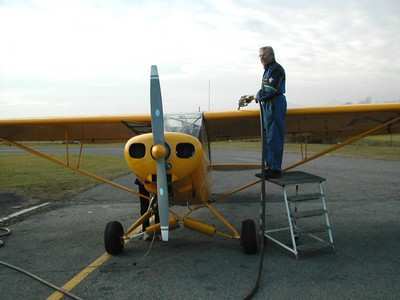Sat, May 30, 2020
EAA Made Clear That The Public Has Limited To No Exposure To EDB In Concentrated Form
EAA recommended the EPA not designate an integral component of avgas, ethylene dibromide (EDB), as a high-priority substance for future study and regulation to avoid profound safety of flight and economic implications that would result from potential control or limitation on EDB, which could effectively limit or eliminate the continued availability of leaded high-octane avgas.

EDB is used as the scavenger for lead in avgas and makes up one of the two major components of the octane-enhancing, lead-additive package used in avgas production called TEL-B, which is principally made up of tetraethyl lead and EDB. Any future efforts to regulate EDB in aviation gasoline under the Toxic Substances Control Act could have the same effect as regulating lead, with serious implications for general aviation. There is no immediate threat to the supply of leaded aviation gasoline, and the current EPA activity to evaluate up to 40 chemicals for prioritization for study and possible future regulation is the first in a multistep process that is likely to take years if it goes forward for EDB at all.
EAA has played a key role through the joint industry/government effort known as the Piston Aviation Fuels Initiative (PAFI) in working to advance the research, development, and eventual FAA authorization of an unleaded aviation gasoline to replace the high-octane leaded gasoline upon which much of the piston-powered general aviation fleet is currently reliant.
Until a time where a safe, operationally effective, and economically viable unleaded replacement is available, TEL-B, and therefore EDB, are necessary components of the avgas the GA fleet requires to operate.
In its comments, EAA made clear that the public has limited to no exposure to EDB in concentrated form for aviation use. EDB is not manufactured in the United States and is only imported from the U.K. as part of the TEL-B lead additive, where it is delivered in sealed containers to the handful of refiners and blenders producing avgas in the U.S. TEL-B is then blended with bulk fuel components in enclosed systems before being distributed for sale. EDB makes up less than one-tenth of one percent of finished avgas by weight.
EAA submitted comments with its stated position early this week, and continues to maintain the development of a future unleaded replacement for 100LL as one of the organization's top priorities.
More News
He Attempted To Restart The Engine Three Times. On The Third Restart Attempt, He Noticed That Flames Were Coming Out From The Right Wing Near The Fuel Cap Analysis: The pilot repor>[...]
Make Sure You NEVER Miss A New Story From Aero-News Network Do you ever feel like you never see posts from a certain person or page on Facebook or Instagram? Here’s how you c>[...]
From 2009 (YouTube Edition): Leading Air Show Performers Give Their Best Advice for Newcomers On December 6th through December 9th, the Paris Las Vegas Hotel hosted over 1,500 air >[...]
Aero Linx: NASA ASRS ASRS captures confidential reports, analyzes the resulting aviation safety data, and disseminates vital information to the aviation community. The ASRS is an i>[...]
“For our inaugural Pylon Racing Seminar in Roswell, we were thrilled to certify 60 pilots across our six closed-course pylon race classes. Not only did this year’s PRS >[...]
 NTSB Final Report: Rutan Long-EZ
NTSB Final Report: Rutan Long-EZ ANN FAQ: Turn On Post Notifications
ANN FAQ: Turn On Post Notifications Classic Aero-TV: ICAS Perspectives - Advice for New Air Show Performers
Classic Aero-TV: ICAS Perspectives - Advice for New Air Show Performers ANN's Daily Aero-Linx (06.28.25)
ANN's Daily Aero-Linx (06.28.25) Aero-News: Quote of the Day (06.28.25)
Aero-News: Quote of the Day (06.28.25)



